- Forum
- categories
- Resource recovery
- Fertiliser, soil conditioner, production of crops
- Urine reuse or infiltration
- Urine Disposal? - Renovating a public urinal maintained and built by a slum settlement in India
Urine Disposal? - Renovating a public urinal maintained and built by a slum settlement in India
6739 views
- AjitSeshadri
-

- Marine Chief Engineer by profession (1971- present) and at present Faculty in Marine Engg. Deptt. Vels University, Chennai, India. Also proficient in giving Environmental solutions , Designation- Prof. Ajit Seshadri, Head- Environment, The Vigyan Vijay Foundation, NGO, New Delhi, INDIA , Consultant located at present at Chennai, India
Re: Urine Disposal? - Renovating a public urinal maintained and built by a slum settlement in India
Dear Muench,
Re: Waterless urinals and their management in Indian scenario.
We need to keep the fitments and accessories simple and basic.
It is needed to be operated and maintained by low-tech skill persons.
At best, all fitments are needed for fail safe flow, masonary fittings, to be robust and only needs cleaning Etc.
Flush water is not available at all locations, only self- clean and minimal water for pan clearing is there. say 1-2 lit per use,
When 5- 10 lit per use are applied, then it is better BOD on effluent - around 500ppm +
As suggested, it is best to have grey water admixed with urine from dry- urinals and duly treated naturally.
Thanks for giving my reference on one of the Community projects applying DEWATS Treatment.
We have observed that the devices put up get sustained when communities use all these wastes as resources and are gainfully used.
The above notings are issued to provide on-site inferences for social and environmental good.
Well wishes.
Prof Ajit Seshadri.
Re: Waterless urinals and their management in Indian scenario.
We need to keep the fitments and accessories simple and basic.
It is needed to be operated and maintained by low-tech skill persons.
At best, all fitments are needed for fail safe flow, masonary fittings, to be robust and only needs cleaning Etc.
Flush water is not available at all locations, only self- clean and minimal water for pan clearing is there. say 1-2 lit per use,
When 5- 10 lit per use are applied, then it is better BOD on effluent - around 500ppm +
As suggested, it is best to have grey water admixed with urine from dry- urinals and duly treated naturally.
Thanks for giving my reference on one of the Community projects applying DEWATS Treatment.
We have observed that the devices put up get sustained when communities use all these wastes as resources and are gainfully used.
The above notings are issued to provide on-site inferences for social and environmental good.
Well wishes.
Prof Ajit Seshadri.
Prof. Ajit Seshadri, Faculty in Marine Engg. Deptt. Vels University, and
Head-Environment , VigyanVijay Foundation, Consultant (Water shed Mngmnt, WWT, WASH, others)Located at present at Chennai, India
Head-Environment , VigyanVijay Foundation, Consultant (Water shed Mngmnt, WWT, WASH, others)Located at present at Chennai, India
Please Log in to join the conversation.
You need to login to reply- Elisabeth
-
- User is blocked
- Freelance consultant since 2012
Less- Posts: 3372
- Karma: 54
- Likes received: 932
Re: Urine Disposal? - Renovating a public urinal maintained and built by a slum settlement in India
Hi Shayontoni,
Thanks for your answers.
Why were the waterless urinals installed in India unsuccessful? Usually if problems arise it's because maintenance of the odour stop devices (be it a rubber/silicon valve or one that has a blocking liquid) was neglected. It's actually better not to install them if maintenance cannot be guaranteed. Otherwise it gives this proven technology a bad name.
Yes, I think a small constructed wetland to treat the greywater and urine together might be the easiest solution. Go for subsurface flow, either horizontal flow or vertical flow (if space is available then horizontal flow is probably easier). As a starting point you can read here on the forum: forum.susana.org/36-constructed-wetlands...nd-infiltration-beds
or Wikipedia also has a pretty good page on constructed wetlands.
What happens with the blackwater (faeces) from the community? Pit latrines and faecal sludge treatment plants?
Regards,
Elisabeth
Thanks for your answers.
Why were the waterless urinals installed in India unsuccessful? Usually if problems arise it's because maintenance of the odour stop devices (be it a rubber/silicon valve or one that has a blocking liquid) was neglected. It's actually better not to install them if maintenance cannot be guaranteed. Otherwise it gives this proven technology a bad name.
Yes, I think a small constructed wetland to treat the greywater and urine together might be the easiest solution. Go for subsurface flow, either horizontal flow or vertical flow (if space is available then horizontal flow is probably easier). As a starting point you can read here on the forum: forum.susana.org/36-constructed-wetlands...nd-infiltration-beds
or Wikipedia also has a pretty good page on constructed wetlands.
What happens with the blackwater (faeces) from the community? Pit latrines and faecal sludge treatment plants?
Regards,
Elisabeth
Dr. Elisabeth von Muench
Freelance consultant on environmental and climate projects
Freelance consultant on environmental and climate projects
The following user(s) like this post: AjitSeshadri
Please Log in to join the conversation.
You need to login to reply- shayontoni
-
Topic AuthorLess
- Posts: 4
- Likes received: 1
Re: Urine Disposal? - Renovating a public urinal maintained and built by a slum settlement in India
Dear Elisabeth.
Thank you for reaching out again. I will try my best to respond to your queries.
1. Why Treatment at all?
The urine currently flows directly into open drains that run from in front of everyone's homes. This is unhygienic and a nuisance as such.
The urine flowing directly into drain eventually leads to the river Yamuna, untreated. The settlement has self declared itself open defecation free, and therefore urine in the drains is not preferred in general.
2. The vandalism
The community is constructing the urinal themselves and vandalism is not as such a problem anymore. There is a sense of ownership and pride in the existing slum settlements.
3. Maintenance
The community has an O&M group that is responsible for the urinal.
4. Light at night.
The urinal has a solar panel and an alternative source of electricity from one of the group member's homes. The electricity bill of which is split amidst the group.
5. Water-less Units
They are not quite common but the government installed some a few years back in public facilities. Mostly unsuccessful. It is not an option for this community. As it is a fixture-less urinal. (Ill attach some images more)
6. Usage of Urinal
There are about 500 men using the urinal during the day. They have an alternative community toilet complex free of cost provided by the government. So urinating in the open is rare.
I did think of the treatment away from the urinal and on the outskirts of the settlement. Can you suggest what rudimentary treatment is needed before rendering this water "fit" for releasing in the city drain?
Like do you think making this diluted grey water urine mixture run through some wetland could make a difference or is it at all needed?
Thank you for your time!
Thank you for reaching out again. I will try my best to respond to your queries.
1. Why Treatment at all?
The urine currently flows directly into open drains that run from in front of everyone's homes. This is unhygienic and a nuisance as such.
The urine flowing directly into drain eventually leads to the river Yamuna, untreated. The settlement has self declared itself open defecation free, and therefore urine in the drains is not preferred in general.
2. The vandalism
The community is constructing the urinal themselves and vandalism is not as such a problem anymore. There is a sense of ownership and pride in the existing slum settlements.
3. Maintenance
The community has an O&M group that is responsible for the urinal.
4. Light at night.
The urinal has a solar panel and an alternative source of electricity from one of the group member's homes. The electricity bill of which is split amidst the group.
5. Water-less Units
They are not quite common but the government installed some a few years back in public facilities. Mostly unsuccessful. It is not an option for this community. As it is a fixture-less urinal. (Ill attach some images more)
6. Usage of Urinal
There are about 500 men using the urinal during the day. They have an alternative community toilet complex free of cost provided by the government. So urinating in the open is rare.
I did think of the treatment away from the urinal and on the outskirts of the settlement. Can you suggest what rudimentary treatment is needed before rendering this water "fit" for releasing in the city drain?
Like do you think making this diluted grey water urine mixture run through some wetland could make a difference or is it at all needed?
Thank you for your time!
Attachments:
-
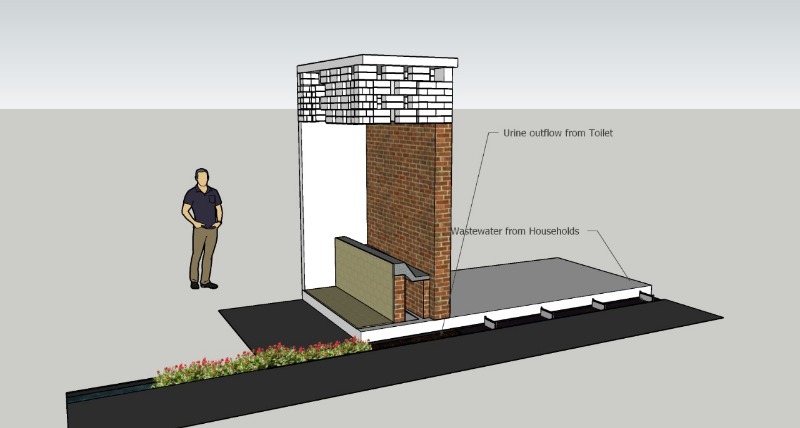 IMG-201904...0011.jpg
(Filesize: 43KB)
IMG-201904...0011.jpg
(Filesize: 43KB)
Please Log in to join the conversation.
You need to login to reply- Elisabeth
-
- User is blocked
- Freelance consultant since 2012
Less- Posts: 3372
- Karma: 54
- Likes received: 932
Re: Urine Disposal? - Renovating a public urinal maintained and built by a slum settlement in India
Dear Shayontoni,
If I was you I wouldn't think too much about fancy treatment processes. I think you'll have other problems to worry about: how to prevent vandalism, keeping the units clean, how to provide lighting at night, water availability if you want to do pour flush (have you thought about using waterless urinals? Are they becoming common in India? I mean like these ones: en.wikipedia.org/wiki/Urinal#Waterless_urinals (or simpler versions of that)). Also how to make sure that men use your urinal rather than urinating elsewhere.
With regards to treatment, if indeed it's required, there might be a need to remove the ammonia content, depending on where the greywater-urine mixture is later treated (is it treated?). Actually, I think you're better off improving the treatment process of the greywater-urine mixture at the end of the drain or sewer, rather than starting up a treatment process directly next to the urinals.
Regards,
Elisabeth
If I was you I wouldn't think too much about fancy treatment processes. I think you'll have other problems to worry about: how to prevent vandalism, keeping the units clean, how to provide lighting at night, water availability if you want to do pour flush (have you thought about using waterless urinals? Are they becoming common in India? I mean like these ones: en.wikipedia.org/wiki/Urinal#Waterless_urinals (or simpler versions of that)). Also how to make sure that men use your urinal rather than urinating elsewhere.
With regards to treatment, if indeed it's required, there might be a need to remove the ammonia content, depending on where the greywater-urine mixture is later treated (is it treated?). Actually, I think you're better off improving the treatment process of the greywater-urine mixture at the end of the drain or sewer, rather than starting up a treatment process directly next to the urinals.
Regards,
Elisabeth
Dr. Elisabeth von Muench
Freelance consultant on environmental and climate projects
Freelance consultant on environmental and climate projects
Please Log in to join the conversation.
You need to login to reply- AjitSeshadri
-

- Marine Chief Engineer by profession (1971- present) and at present Faculty in Marine Engg. Deptt. Vels University, Chennai, India. Also proficient in giving Environmental solutions , Designation- Prof. Ajit Seshadri, Head- Environment, The Vigyan Vijay Foundation, NGO, New Delhi, INDIA , Consultant located at present at Chennai, India
Re: Urine Disposal? - Renovating a public urinal maintained and built by a slum settlement in India
Dear Shanyatoni.
For your initiative for remediation of 300px urine say 400lit.0.4 cbm. can proceed in suggested line as below:
- Have a holding space- tank of say 4-5 days @ 2 kl 2000lit able to drain by gravity. Urinals and tank made on elevated ground. Process flow 1:100 gradient flow
- Into next primary stage anarebobic admixed with cow dung, bio mass eucalyptus. veg market kitchn wste.
Tank for 15 dys 25-30 kl.cbm. capacity.
- 2 tanks are maintained each 25kl to alternate.
- This bio matter would reduce in size to 30% level..
- Matter ideal for vermi composting in open aerated pits.
- As the compost gets matured and prepared can be drawn to outlet zone.
- Regularly once a week the matter in finished / polished stage is removed and sun- dried.
- The above stages could be tried on a pilot scale down sized for getting confidence in the remediation process.
- 25 kl bio-matter would evolve from 4000lit.. 4 cbm compost looking like tea leaves.
- 4000 lit say 3000kgs of vermi manure can suffice for a 1 acre 4000sqm sgri- farm
- This could be evolved as appropriate at each of the sites with adaptation as required.
Well wishes.
Prof Ajit Seshadri
Vels University. Chennai.
For your initiative for remediation of 300px urine say 400lit.0.4 cbm. can proceed in suggested line as below:
- Have a holding space- tank of say 4-5 days @ 2 kl 2000lit able to drain by gravity. Urinals and tank made on elevated ground. Process flow 1:100 gradient flow
- Into next primary stage anarebobic admixed with cow dung, bio mass eucalyptus. veg market kitchn wste.
Tank for 15 dys 25-30 kl.cbm. capacity.
- 2 tanks are maintained each 25kl to alternate.
- This bio matter would reduce in size to 30% level..
- Matter ideal for vermi composting in open aerated pits.
- As the compost gets matured and prepared can be drawn to outlet zone.
- Regularly once a week the matter in finished / polished stage is removed and sun- dried.
- The above stages could be tried on a pilot scale down sized for getting confidence in the remediation process.
- 25 kl bio-matter would evolve from 4000lit.. 4 cbm compost looking like tea leaves.
- 4000 lit say 3000kgs of vermi manure can suffice for a 1 acre 4000sqm sgri- farm
- This could be evolved as appropriate at each of the sites with adaptation as required.
Well wishes.
Prof Ajit Seshadri
Vels University. Chennai.
Prof. Ajit Seshadri, Faculty in Marine Engg. Deptt. Vels University, and
Head-Environment , VigyanVijay Foundation, Consultant (Water shed Mngmnt, WWT, WASH, others)Located at present at Chennai, India
Head-Environment , VigyanVijay Foundation, Consultant (Water shed Mngmnt, WWT, WASH, others)Located at present at Chennai, India
Please Log in to join the conversation.
You need to login to reply- shayontoni
-
Topic AuthorLess
- Posts: 4
- Likes received: 1
Re: Urine Disposal? - Renovating a public urinal maintained and built by a slum settlement in India
Thank you Elizabeth for your response!
Some information for clarity:
1. The urinals are going to have pour flush. This is however not set in stone, depending on the eventual design. There is not going to be any fixtures as such but a sloping slab. I will attach a rough sketch for your understanding.
2. Number of users - 250-300 men per day
3. Nutrient retrieval for use as fertilizer is not an option due to a) lack of land/permissions b)Space constraints
4. My intent : To meet the basic requirements of wastewater disposal before disposing it off into the city drain (which has a lot of grey water coming from the rest of the settlement). Towards this extent, I would like to understand what form of rudimentary treatment can I inculcate.
Should I look at Tertiary Treatments for disposal of Urine?
1. Constructed wetlands (Free-Water Surface Constructed Wetland,etc.) / Reed beds or Non Planted filters?
2. layers of Sand Gravel
3. layers of sawdust and hay like in the Paris Urinals
Is there something I am missing? Urine has very low BOD and Pathogen Level so I am assuming a tertiary wastewater treatment via baffled reactor or root zone treatments
Thank you for your help!
Some information for clarity:
1. The urinals are going to have pour flush. This is however not set in stone, depending on the eventual design. There is not going to be any fixtures as such but a sloping slab. I will attach a rough sketch for your understanding.
2. Number of users - 250-300 men per day
3. Nutrient retrieval for use as fertilizer is not an option due to a) lack of land/permissions b)Space constraints
4. My intent : To meet the basic requirements of wastewater disposal before disposing it off into the city drain (which has a lot of grey water coming from the rest of the settlement). Towards this extent, I would like to understand what form of rudimentary treatment can I inculcate.
Should I look at Tertiary Treatments for disposal of Urine?
1. Constructed wetlands (Free-Water Surface Constructed Wetland,etc.) / Reed beds or Non Planted filters?
2. layers of Sand Gravel
3. layers of sawdust and hay like in the Paris Urinals
Is there something I am missing? Urine has very low BOD and Pathogen Level so I am assuming a tertiary wastewater treatment via baffled reactor or root zone treatments
Thank you for your help!
Attachments:
-
 IMG_201604...5652.jpg
(Filesize: 79KB)
IMG_201604...5652.jpg
(Filesize: 79KB)
-
xxxxxxxxxx...xxxx.JPG (Filesize: 50KB)
-
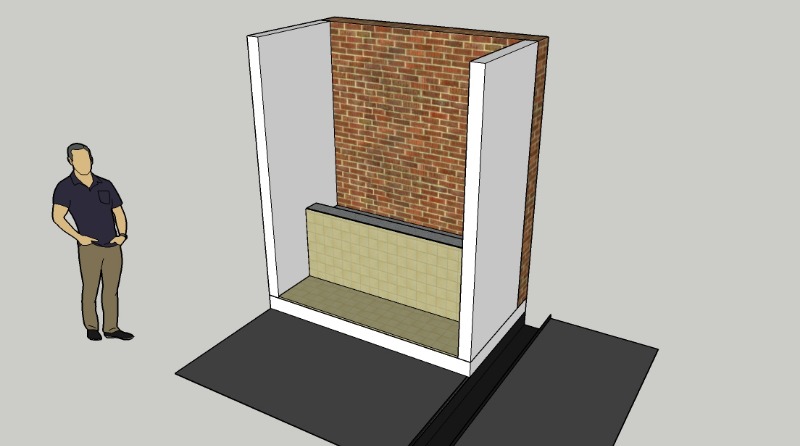 UrinalDesi...2019.jpg
(Filesize: 45KB)
UrinalDesi...2019.jpg
(Filesize: 45KB)
-
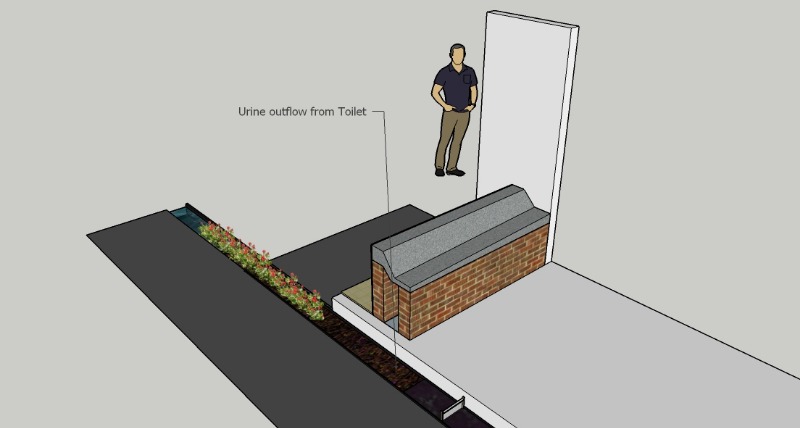 sssssssssssssssss.jpg
(Filesize: 35KB)
sssssssssssssssss.jpg
(Filesize: 35KB)
The following user(s) like this post: AjitSeshadri
Please Log in to join the conversation.
You need to login to reply- Elisabeth
-
- User is blocked
- Freelance consultant since 2012
Less- Posts: 3372
- Karma: 54
- Likes received: 932
Re: Urine Disposal? - Renovating a public urinal maintained and built by a slum settlement in India
Are you going to build waterless urinals or water-flushed ones? Have you estimated how much urine would be produced at this location each day?
If you use waterless urinals you would be collecting pure urine. In my opinion it would not be advisable to try and "treat" the urine for ammonia removal as that would require quite some treatment steps (see here in the discussion forum for some information on urine treatment: forum.susana.org/urine-treatment). Can you rather utilise the urine as a fertiliser somewhere in the area? But then how would you organise the transport of the urine?
Here in this category you can find previous discussions about urine reuse and urine infiltration:
forum.susana.org/175-urine-reuse-or-infiltration
I am pretty sure you will find some useful information there.
Where does the existing drain discharge to? Will the small amount of urine added from your urinals really make much difference in the scheme of things (with regards to surface water or groundwater pollution)? Looking at your pictures you have a whole range of problems to deal with there...
Regards,
Elisabeth
If you use waterless urinals you would be collecting pure urine. In my opinion it would not be advisable to try and "treat" the urine for ammonia removal as that would require quite some treatment steps (see here in the discussion forum for some information on urine treatment: forum.susana.org/urine-treatment). Can you rather utilise the urine as a fertiliser somewhere in the area? But then how would you organise the transport of the urine?
Here in this category you can find previous discussions about urine reuse and urine infiltration:
forum.susana.org/175-urine-reuse-or-infiltration
I am pretty sure you will find some useful information there.
Where does the existing drain discharge to? Will the small amount of urine added from your urinals really make much difference in the scheme of things (with regards to surface water or groundwater pollution)? Looking at your pictures you have a whole range of problems to deal with there...
Regards,
Elisabeth
Dr. Elisabeth von Muench
Freelance consultant on environmental and climate projects
Freelance consultant on environmental and climate projects
Please Log in to join the conversation.
You need to login to reply- DaveBates
-
 Less
Less- Posts: 49
- Likes received: 17
- shayontoni
-
Topic AuthorLess
- Posts: 4
- Likes received: 1
Urine Disposal
Hello everyone.
I am currently in the process of renovating a public urinal maintained and built by a slum settlement. The urine flows directly into a drain (carrying greywater and stormwater- as is the usual case for slums).
After having gone through most information I could find online, i have the following queries for you:
1. What kind of wastewater treatments can I engage in before the urine wastewater becomes fit for being released in the drain.
2. What kind of treatment is needed before this wastewater can be soaked/leached into the soil without affecting the soil/ water table (the water table right now is estimated to be at 130)
3. What kind of treatment is needed before I can use it for irrigation.
My intent is to dispose it off having met certain BOD,etc criteria. The urinal caters to about 1000 men or less.
I am currently in the process of renovating a public urinal maintained and built by a slum settlement. The urine flows directly into a drain (carrying greywater and stormwater- as is the usual case for slums).
After having gone through most information I could find online, i have the following queries for you:
1. What kind of wastewater treatments can I engage in before the urine wastewater becomes fit for being released in the drain.
2. What kind of treatment is needed before this wastewater can be soaked/leached into the soil without affecting the soil/ water table (the water table right now is estimated to be at 130)
3. What kind of treatment is needed before I can use it for irrigation.
My intent is to dispose it off having met certain BOD,etc criteria. The urinal caters to about 1000 men or less.
Attachments:
-
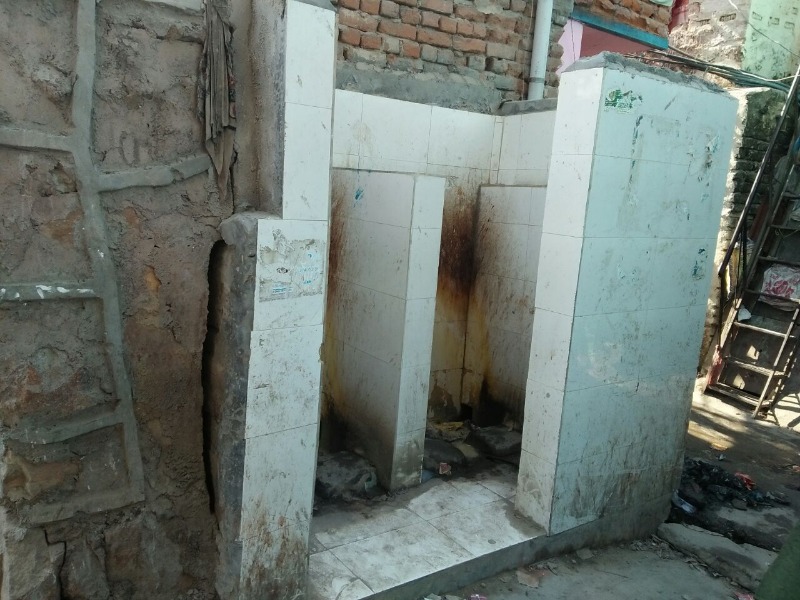 23-11-201713.jpeg
(Filesize: 145KB)
23-11-201713.jpeg
(Filesize: 145KB)
-
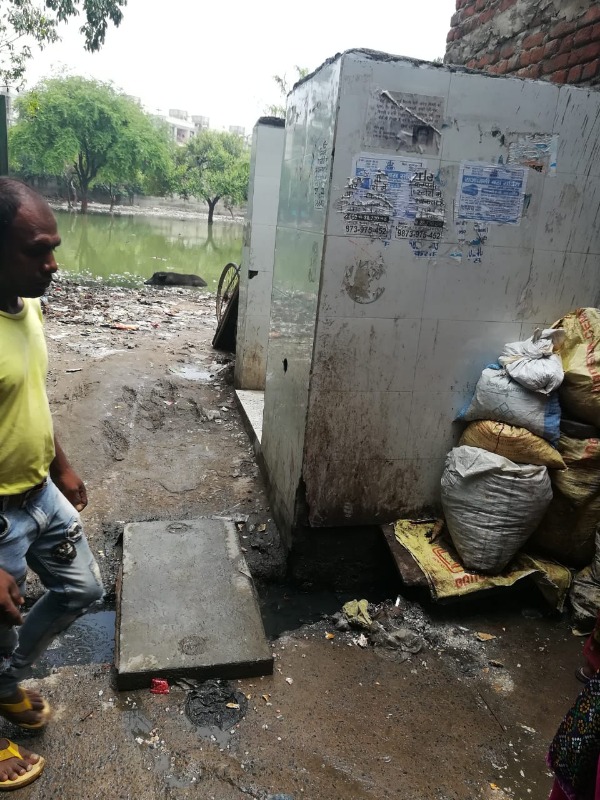 WhatsAppIm...8PM.jpeg
(Filesize: 174KB)
WhatsAppIm...8PM.jpeg
(Filesize: 174KB)
-
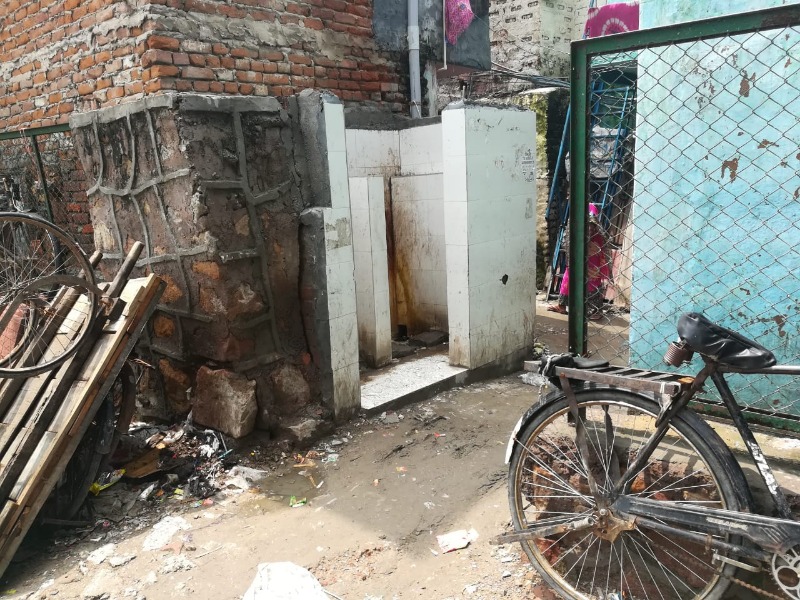 WhatsAppIm...9PM.jpeg
(Filesize: 214KB)
WhatsAppIm...9PM.jpeg
(Filesize: 214KB)
Please Log in to join the conversation.
You need to login to reply
Share this thread:
- Forum
- categories
- Resource recovery
- Fertiliser, soil conditioner, production of crops
- Urine reuse or infiltration
- Urine Disposal? - Renovating a public urinal maintained and built by a slum settlement in India
Recently active users. Who else has been active?
Time to create page: 0.150 seconds







